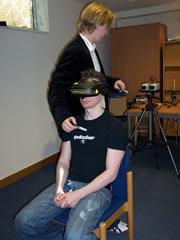 This viewer may begin to think that he is where the camera is... watching himself from there. Click to see a video of the other, similar experiment.Henrik Ehrsson / Science
This viewer may begin to think that he is where the camera is... watching himself from there. Click to see a video of the other, similar experiment.Henrik Ehrsson / ScienceScientists have deliberately fooled people into feeling they are watching themselves from outside their own bodies, using virtual-reality technology. The achievement reveals how the brain can be confused as it struggles to integrate confusing information from the different senses.
People who claim to have had out-of-body experiences (OBEs) — most famously patients on the operating table or those who have narrowly avoided death — describe a sensation of having floated out of themselves, for example towards the ceiling of an operating theatre. From there they watch their body and activities surrounding it.
Such experiences have been claimed by spiritualists to represent evidence of a soul. But the new research shows that it is possible to create a similar sensation simply by tricking the mind.
Understanding how the mind sometimes perceives itself as journeying out of the body could help with the development of more realistic computer games or remote robotic systems, or even help to understand the brains of those who claim to experience the phenomenon naturally, such as schizophrenics or epileptics.
You, me, me, you
The effect was created in two separate experiments described in Science1,2 this week, both of which used a simple method to fool volunteers into thinking that their minds had been displaced outside their bodies. In each case, participants wore virtual-reality goggles hooked up to cameras trained on their own bodies.
In one study, carried out by Henrik Ehrsson at University College London, volunteers were then prodded in the chest at precisely the same moment that an object approached the camera. In this scenario, the volunteers identified strongly with the location of the camera, thinking that this is where their true self was — the view of their body was like a view of someone else.
In the other experiment, led by Olaf Blanke of the Swiss Federal Institute of Technology in Lausanne, patients viewed a camera image of their own back being stroked, while their own back was stroked too. In this instance, volunteers identified strongly with the picture of their back, thinking that this was their location - again outside their own body.
Too much information
The bizarre effect happens because, although we usually perceive ourselves to be within our bodies, the experimental set-up meant that the sensory information being supplied to the brain did not fit with this idea, Ehrsson explains. "The brain can trick itself internally because it is always trying to make sense of information — if that information is flawed or erroneous, it could come up with the wrong interpretation."
The method does not recreate the 'classical' OBE — most strikingly because in the real-world setting, there's no obvious way for a person to 'see' themselves. But people could perhaps draw on their own mental body image to create the effect, says Ehrsson. "In the operating theatre there is no mirror on the ceiling, but there could be a 'mirror' in the head," he says. Ehrsson and Blanke suspect that this illusion might involve some sort of malfunction in brain regions such as the tempoparietal cortex that integrate sensory information.
Nevertheless, "this new experiment has at last brought OBEs into the lab and tested one of the main theories of how they occur", comments Susan Blackmore, a psychologist at the University of the West of England in Bristol. "Finding out that OBEs are a perfectly natural phenomenon does not prove there is not astral body, or soul, or spirit, but it certainly makes their invention superfluous."
Suspended disbelief
The effect even works for plastic mannequins, as Blanke's team discovered when they replaced the subject's own image with that of a female dummy purchased for just 100 Swiss francs (US$83) (see video). But when they used a simple square of metal as the image, the OBE effect did not materialize, showing that the trick can only be stretched so far.
ADVERTISEMENT
Finding out exactly how much subjects can suspend their disbelief will be crucial in developing the technology to allow users to assume different personas, from remote robots to virtual-reality avatars, Blanke says.
Using appropriate visual and tactile information to convey a feeling of operating in the body of a robot or virtual character could help with applications ranging from NASA's Robonaut project, which aims to control robots on the Moon, to surgeons performing operations over the Internet. "These applications could be improved if you could get the illusion that you really are in that place — you could act much more intuitively," Ehrsson says.
Visit our mimicsoutofbody_expe.html">newsblog to read and post comments about this story.
